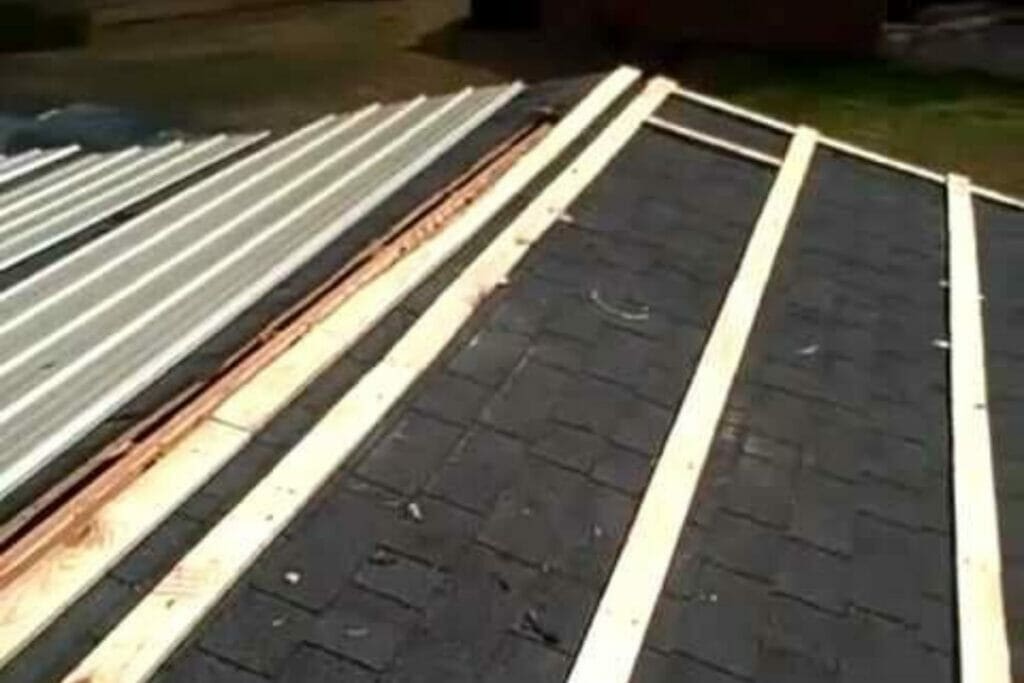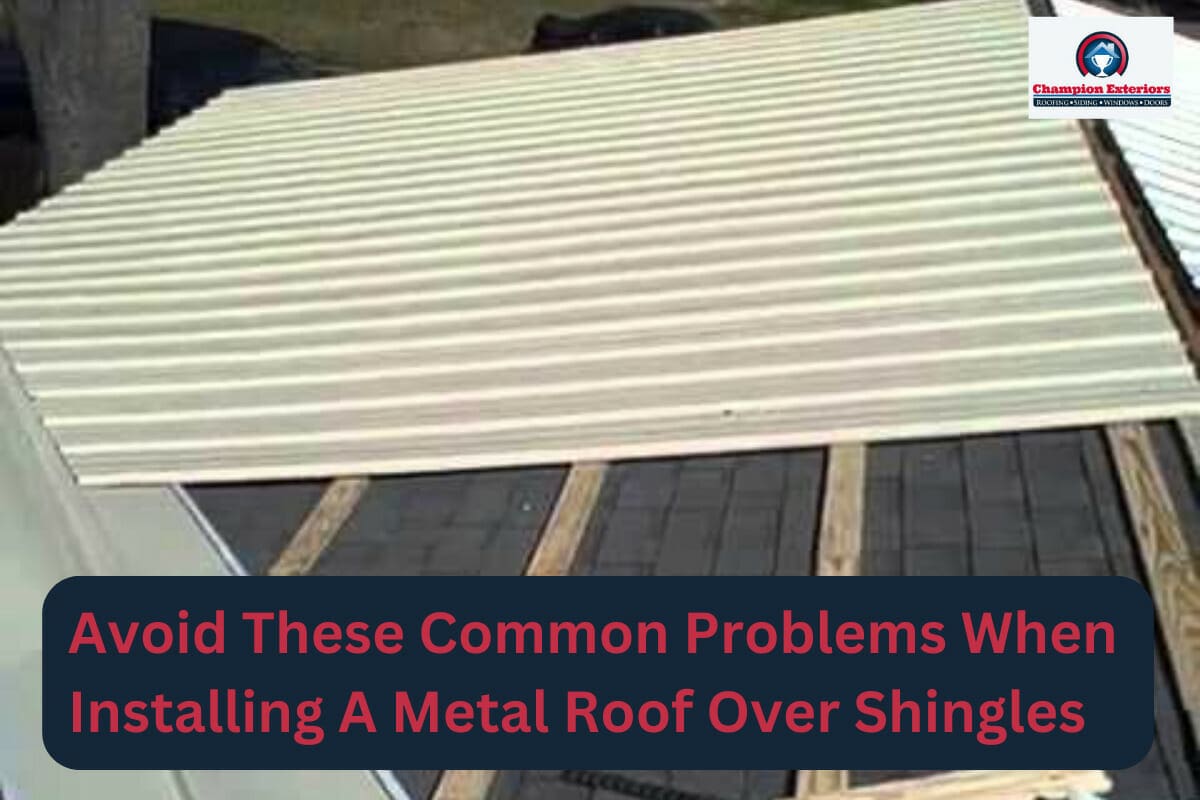Do you have the temptation to install a metal roof over shingles? Though installing a metal roof over a shingle roof has many advantages, it also has its share of disadvantages. So before you install a metal roof over shingles, make sure you are prepared for potential issues.
This blog post will guide you through the common problems seen when installing a metal roof over a shingle roof and ways to avoid them. By the end of this guide, you will be equipped with everything you need to know before you choose this unique approach to installing a new metal roof.
What Is A Metal Roof Over Shingles?

Before we get into the main content of this blog post, let’s first understand why someone might install a metal roof over shingles.
Installing a metal roof over shingles seems to be a quick and easy approach to a more durable and cost-effective roofing system. Since the existing shingles deteriorate and fade as they age, the added layer of metal provides them extra protection. The metal roof enhances the look of your home while also making it resilient to all types of weather.
With this roofing method, rather than removing the old shingles from the roof, metal roofing panels are simply placed over the top of the existing shingle roof.
But the question arises: Why would homeowners want to install a metal roof over shingles? To avoid the cost of removing the existing shingles? Or, do they want to avoid putting old shingles in landfills?
In this following section, we will go over all the reasons why homeowners might want to install a metal roof over a shingle roof.
Why Homeowners Install A Metal Roof Over Shingles
Homeowners may choose to put a metal roof over a shingle one for many reasons.
1. Potential Savings
By installing a metal roof over shingles, homeowners can save money on a number of expenses.
a) Labor Costs: Removing shingles is labor-intensive work. By keeping the old shingles in place, you can save on the labor costs associated with shingle removal.
b) Disposal Fees: Removing old shingles typically involves fees for hauling them away and disposing of them in a landfill. By leaving the shingles in place, you avoid these disposal costs.
c) Time Saved: Installing a metal roof over shingles is generally faster than a full tear-off and replacement. This can result in reduced labor costs and less disruption to your daily life.
2. Added Insulation And Increased Energy Efficiency
Roof insulation and your home’s energy efficiency go hand in hand. Adding more insulation to your roof will increase your home’s energy efficiency, which consequently reduces your energy costs.
By installing a metal roof over your shingles, many homeowners believe they’re adding more insulation to the roofing system. Moreover, metal roofs are known for their high insulation properties and energy efficiency. By reflecting most of the sun’s heat, they help maintain the temperature inside. In addition, the added insulation balances your home’s temperature and humidity level and increases the ventilation.
Metal roofs are initially expensive, but their long lifespans help homeowners save over time. With minimal maintenance compared to asphalt shingles, you can enjoy the benefits of metal roofs for decades.
3. Enhanced Durability And Longevity
Metal roofs are more durable and long-lasting than regular asphalt shingles. With proper installation and the right care, your metal roof can last for 50 years or more. Metal roofs are known for being extremely durable and resistant to impacts, severe weather, and UV rays. When installed over a shingle roof, a metal roof offers these same benefits with the added bonus of reduced noise and increased insulation.
Common Problems With Metal Roofs Over Shingles
1. Old Roof Decking Concerns
One of the important components of the roofing system is the roof deck. The roof deck is typically thoroughly inspected every time a new roof is installed and damaged rafters are replaced. The deck ensures the proper installation and sustainability of the roofing materials.
However, this isn’t the case when you’re installing a metal roof over shingles. Instead, during this type of installation, the old deck remains uninspected, unrepaired, and susceptible to damage. Also, once the roofers have installed the metal roof, they face difficulty with finding damage to the roof deck and old shingles. This only creates bigger problems in the long run.
2. Added Weight Concerns
Metal roofs are heavier than other roofing materials on their own, and when combined with shingles, the increased weight can result in potential hazards and even a roof collapse. If you are planning to install a metal roof over shingles, make sure the structure of your home can support the added weight. Especially for older buildings, the added weight can be a concern for homeowners.
3. Old Shingles Continue to Deteriorate
If you are installing a metal roof over shingles, the chances are that the old roof will continually decay or deteriorate with time. What’s worse, is that a layer of moisture can form between the old shingle roof and the metal roof. This moisture can seep into the existing shingles, which may result in mold, mildew, and water damage. This also provides pathways for water to further infiltrate, reaching the roof deck and eventually the home interior.
This type of water damage is hard to spot and repair for roofers, so it’s best to avoid this roofing option if you’re worried about the structure of your roof. Overall, It’s important to weigh all the pros and cons if you are planning to install metal over an existing roof.
How To Avoid Problems When Installing A Metal Roof Over Shingles
To avoid the problems associated with installing a metal roof over shingles, consider the following steps and precautions:
1. Inspect And Repair The Roof Deck:
Before installing a metal roof over shingles, thoroughly inspect the existing roof deck. Consider replacing any damaged or rotting sections to ensure a solid and reliable foundation for the metal roof. Properly address issues with the existing structure to prevent future problems and extend the lifespan of your roof.
2. Evaluate Structural Integrity
Assess the structural integrity of your home to determine if it can support the additional weight of the metal roof and the existing shingles. Consult with a structural engineer or a roofing professional to ensure your home’s structure can handle the extra weight. Reinforce the structure if necessary.
3. Consider the Right Roofing Materials
Choose lightweight metal roofing materials to minimize the added weight. Various types of lightweight metal roofing options are available, such as aluminum or metal shingles, which can reduce the load on your roof’s structure.
4. Address Ventilation and Insulation:
Proper ventilation and insulation are essential when installing a metal roof over shingles. Ensure there is adequate ventilation to prevent moisture buildup and the formation of mold or mildew between the old shingles and the new metal roof. Proper insulation can also help regulate temperature and reduce energy costs.
5. Install A Roofing Underlayment:
To provide an extra layer of protection against water infiltration, consider installing a high-quality underlayment between the old shingles and the metal roof. This can help prevent water from seeping between the layers and into the home.
6. Consult A Professional Roofer
Working with an experienced roofing contractor with expertise in metal roof installations over existing shingles is important. They can provide guidance, ensure proper installation, and address any concerns specific to your project.
Conclusion
While installing a metal roof over shingles can be a cost-effective choice, it’s essential to be aware of potential problems and take preventive measures. Addressing issues related to moisture, insulation, additional weight, and the condition of the roof deck can help you enjoy the benefits of a metal roof without headaches.
However, if a roofing contractor advises against installing a metal roof over shingles, you should listen to their advice. Some building codes will not allow metal roofs to be installed over shingles due to the issues we addressed above. Check your town or city’s guidelines before building to ensure you don’t find yourself in legal trouble.
The Best Roofing Services In New Jersey
Are you looking to replace or install a new roof in your home or office in New Jersey? Then you must be looking for a skilled, reliable, and trusted roofing contractor.
Champion Exteriors in New Jersey is a renowned and reliable roofing contractor whom you can trust. Our team of roofers is proficient at handling all roofing services, including roof installation, replacement, and repair. Contact us today at (609) 845-3576 for your roof replacement.
FAQs
A. Installing a metal roof over two layers of shingles is generally not recommended, as this can increase the risk of weight-related problems and reduce the roof’s lifespan.
A. With proper installation and maintenance, a metal roof over shingles can last around 20 to 40 years or more, depending on the material used.
A. Yes, a metal roof can increase energy efficiency by reflecting heat, reducing cooling costs in hot climates, and providing better insulation.
A. While it’s possible to do this project yourself, hiring professionals with experience in metal roofing is recommended to ensure a trouble-free installation.
A. Consider factors like climate, budget, and the desired appearance of your home when selecting a metal roofing material. Consult with experts for guidance.


